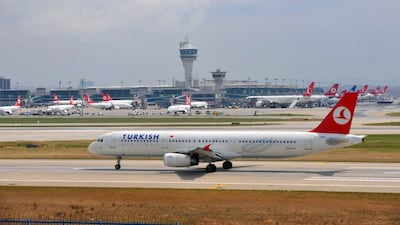The name Dubai World Central reflects the emirate’s ambition to be at the crossroads of global air travel. Istanbul is seeking the same thing.
Turkish Airlines aims to almost double its fleet to 450 aircraft by 2023, up from its current 263. By the end of this year, it plans to operate 300 jets.
Such growth lays down a challenge to the region's big three of Emirates Airline, Etihad Airways and Qatar Airways, which are competing to establish international hubs in Dubai, Abu Dhabi and Doha.
The Turkish carrier employs some of the biggest names in football, including Lionel Messi and Didier Drogba, to promote its Widen Your World campaign. It is exactly the sort of mega-budget marketing push featuring top sporting names that would typically be associated with one of the big Gulf carriers – especially Emirates, which is estimated to spend more than Dh1 billion each year on sponsorship deals alone.
“Turkish’s high-growth rate will bring it more into competition with the Middle East big three,” said Will Horton, a senior analyst at the Centre of Aviation (Capa).
“Not all growth will overlap, but certainly much will,” he added.
The Turkish airline's ambitions are also reflected in the growth of the airport, which mimics the trajectory of Dubai. Istanbul Ataturk Airport attracted almost 57 million passengers last year, up 11 per cent on 2013.
Its growth in percentage terms outpaced Dubai, where passenger numbers grew 6.1 per cent to 70.47 million over the same period. Dubai also set a new record this week with 6.8 million passengers in January.
Abu Dhabi recorded 20 million passengers, an increase of 20 per cent, while traffic through Doha gained 13 per cent to 26.35 million passengers.
In 2013, Dubai completed the first phase of its second airport Al Maktoum International. Last year, Qatar opened Hamad International Airport, while Abu Dhabi International said it would open its Midfield Terminal, a huge facility designed to handle 30 million passengers a year, in 2017.
Istanbul’s new airport is set to open its first phase in 2017. With $35bn of investments, it will have six runways, 500 aircraft parking spots and the capacity to accommodate 150 million passengers.
“The new airport should help some logistical challenges, while Turkish needs to prove it can grow while maintaining service quality, a current concern of frequent flyers,” said Mr Horton.
“Turkish Airlines’ geography makes its market access different from Gulf carriers. Europe is closer and can be accessed with narrow-body aircraft, while many points in Africa can also be reached with narrow-body aircraft. North America can be more readily reached with smaller wide-body aircraft.”
The rise of the Arabian Gulf carriers has been helped in recent years by the purchase of bigger planes such as the Airbus A380, which have created economies of scale for carriers such as Emirates.
Turkish Airlines is yet to operate the world’s biggest passenger aircraft. However it is reported to be considering the lease of six A380s from Malaysian Airlines. That would give the carrier significantly increased operational capacity without the hefty financial outlay of buying the planes.
Emirates, Etihad and Qatar Airways are all now operating the A380 with Etihad and Qatar coming late to the game, receiving the double-decker aircraft only last year.
Last week Turkish Airlines reported a near-tripling of 2014 net profit and said it planned to invest more than $3.74bn into its business this year.
That is expected to fuel further competition with its rivals to the south.
“Due to its geographic location, Turkish Airlines is in a better position to compete with Emirates in North America and Europe,” said Kerem Tezcan, a director at BGC Partners Securities.
“Australia is not their focus in terms of competition and Asia is a region that they will be focusing on in the next couple of years. They will do that by increasing the number of slots or using superjumbo jets.”
selgazzar@thenational.ae
Follow The National's Business section on Twitter

